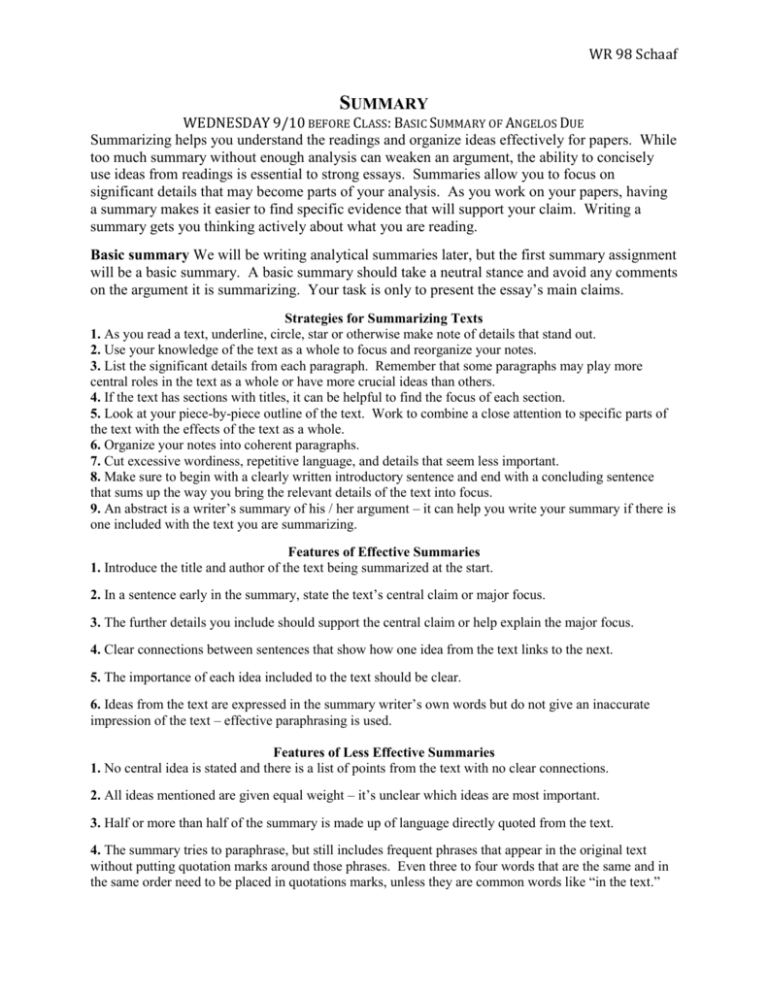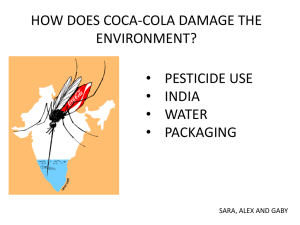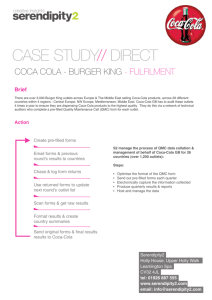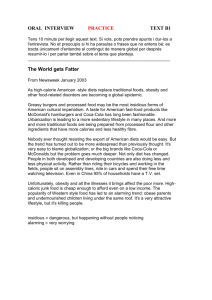098 Summary Schaaf
advertisement

WR 98 Schaaf SUMMARY WEDNESDAY 9/10 BEFORE CLASS: BASIC SUMMARY OF ANGELOS DUE Summarizing helps you understand the readings and organize ideas effectively for papers. While too much summary without enough analysis can weaken an argument, the ability to concisely use ideas from readings is essential to strong essays. Summaries allow you to focus on significant details that may become parts of your analysis. As you work on your papers, having a summary makes it easier to find specific evidence that will support your claim. Writing a summary gets you thinking actively about what you are reading. Basic summary We will be writing analytical summaries later, but the first summary assignment will be a basic summary. A basic summary should take a neutral stance and avoid any comments on the argument it is summarizing. Your task is only to present the essay’s main claims. Strategies for Summarizing Texts 1. As you read a text, underline, circle, star or otherwise make note of details that stand out. 2. Use your knowledge of the text as a whole to focus and reorganize your notes. 3. List the significant details from each paragraph. Remember that some paragraphs may play more central roles in the text as a whole or have more crucial ideas than others. 4. If the text has sections with titles, it can be helpful to find the focus of each section. 5. Look at your piece-by-piece outline of the text. Work to combine a close attention to specific parts of the text with the effects of the text as a whole. 6. Organize your notes into coherent paragraphs. 7. Cut excessive wordiness, repetitive language, and details that seem less important. 8. Make sure to begin with a clearly written introductory sentence and end with a concluding sentence that sums up the way you bring the relevant details of the text into focus. 9. An abstract is a writer’s summary of his / her argument – it can help you write your summary if there is one included with the text you are summarizing. Features of Effective Summaries 1. Introduce the title and author of the text being summarized at the start. 2. In a sentence early in the summary, state the text’s central claim or major focus. 3. The further details you include should support the central claim or help explain the major focus. 4. Clear connections between sentences that show how one idea from the text links to the next. 5. The importance of each idea included to the text should be clear. 6. Ideas from the text are expressed in the summary writer’s own words but do not give an inaccurate impression of the text – effective paraphrasing is used. Features of Less Effective Summaries 1. No central idea is stated and there is a list of points from the text with no clear connections. 2. All ideas mentioned are given equal weight – it’s unclear which ideas are most important. 3. Half or more than half of the summary is made up of language directly quoted from the text. 4. The summary tries to paraphrase, but still includes frequent phrases that appear in the original text without putting quotation marks around those phrases. Even three to four words that are the same and in the same order need to be placed in quotations marks, unless they are common words like “in the text.” WR 98 Schaaf Coca-Cola Will Display Red Warning Logo by Sean Poulter Coca-Cola has agreed to put a red warning logo on its cans to indicate high sugar content following a U-turn by bosses. The company has decided to adopt the color coded system of traffic light labels, which is designed to help consumers identify healthy products and improve their diet. Coca-Cola, like many other international brands, has long fought against the use of color coded labels, largely because they did not want a red warning logo on cans and bottles. However, it has now decided to fall into line, not least because sales of its full sugar original versions are actually well below those for its healthier alternatives, Coke Zero and Diet Coke. The traffic light labeling system uses red, amber and green on a front of pack nutrition label to identify whether products are high, medium, or low in sugar, fat, and salt. There are also figures to show how much one portion of the product contributes to the daily recommended maximum. The company said its adoption of the new labels is consistent with a commitment to provide consumers with transparent nutrition information on the front of its packs. Modified from text at: http://www.dailymail.co.uk/health/article-2744972/Coca-Cola-display-redwarning-logo-cans-indicate-high-sugar-content-U-turn-bosses.html Evaluate the following summaries of “Coca-Cola Will Display Red Warning Logo.” What are the strengths and weaknesses of each summary? What purpose might each serve? 1. The Coca-Cola company has surrendered to pressure and opted to include color coded warnings on its products. This warning system uses red, amber and green on a front of pack nutrition label to identify whether products are high, medium, or low in sugar, fat, and salt. 2. In “Coca-Cola Will Display Red Warning Logo,” Sean Poulter informs readers of a change in the policy of the Coca-Cola company. The soft drink corporation will now mark its products with a colorcoded warning label that indicates the level of sugar, fat, and salt in the drink. 3. There is a warning system that uses the colors of traffic lights to indicate the level of fat, sugar, and salt in products. Red lights mean a high level of fat, sugar, and salt, amber lights mean medium, and green lights mean less. Coca-Cola is using this system. 4. Sean Poulter’s “Coca-Cola Will Display Red Warning Logo” describes a shift in the company’s labeling. Coca-Cola will now include warnings on all its products that used the colors of traffic light’s to indicate each products level of sugar, fat, and salt. 5. International brands have fought the use of color-coded warning systems. Healthier drinks are now more popular than less healthy drinks. Coca-Cola is adopting the warning system, according to Poulter. 6. “Coca-Cola Will Display Red Warning Logo” reveals that the Coca-Cola company has decided to shift its labeling policies due to greater desires of consumers for healthy beverage alternatives. Higher sales of its healthier products have motivated the corporation to include more direct warning labels on its cans. 7. Coke will change its warning labels to include symbols that look like traffic signals. Their healthy drinks now sell better than their less healthy drinks. 8. Coca-Cola claims its decision to include new warning labels about sugar, fat, and salt “is consistent with a commitment to provide consumers with transparent nutrition information on the front of its packs.” 9. Sean Poulter describe how the Coca-Cola company tries to improve the health of its customers by adopting a new warning label system. 10. After years of opposition, Poulter describes how Coca-Cola is adopting a color-coded warning system that relates to nutrition and how the product “contributes to the daily recommended maximum.”





